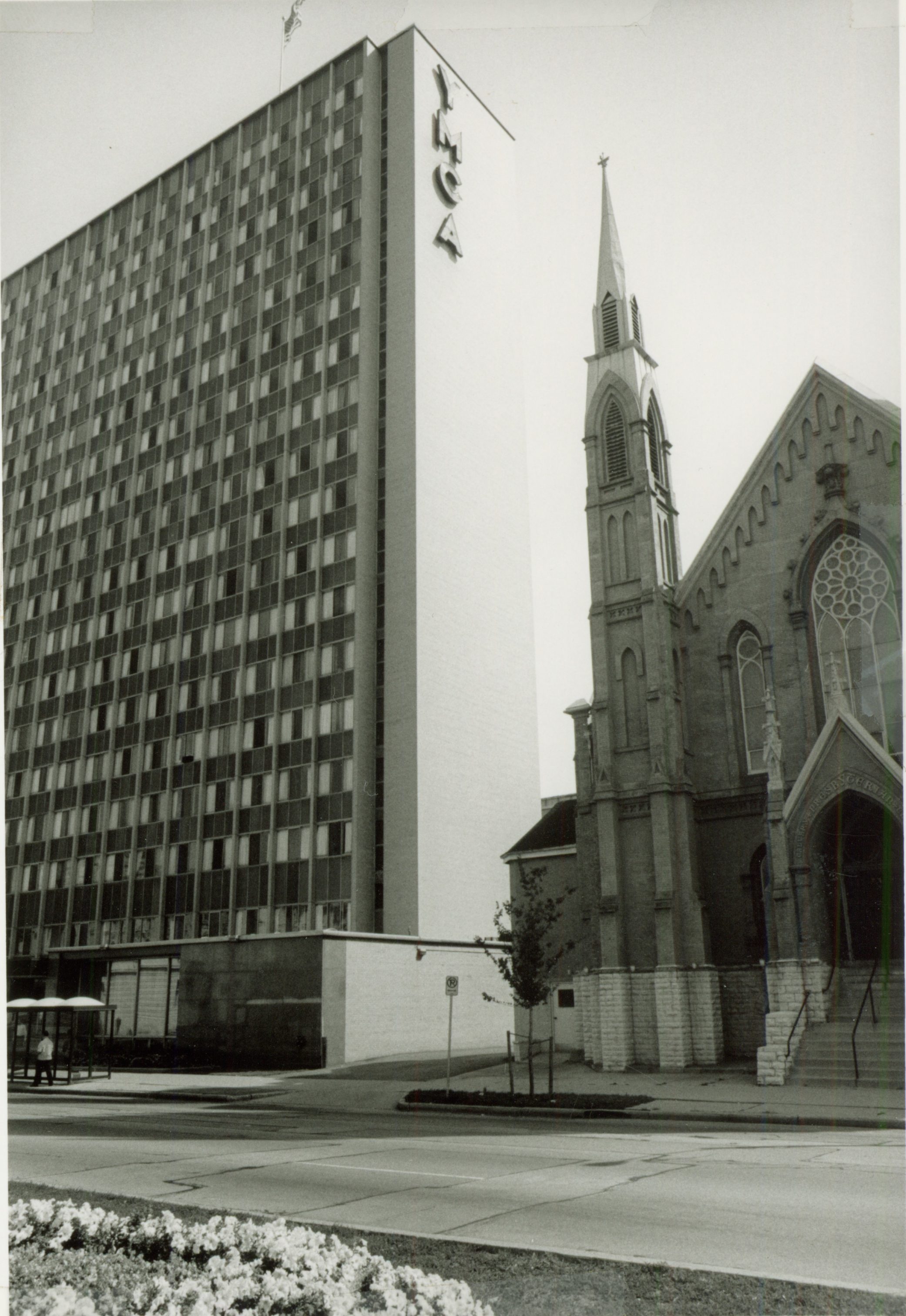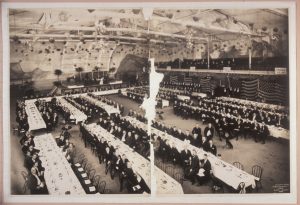Local Protestant church leaders founded the Young Men’s Christian Association (YMCA) of Milwaukee in 1858 at a meeting at Plymouth Congregational Church.[1] Grounded in the Christian revivalism of the late 1850s, Milwaukee’s YMCA served the young men migrating to the rapidly industrializing city.[2] Early on, the association’s program featured fellowship and prayer meetings, educational lectures, recreational activities, and affordable lodging, while relying on subscription dues to remain solvent.[3]
Following institutionally-dormant periods during the Civil War and Reconstruction Era, local business leaders like Alexander Mitchell, Edward P. Allis, and John Plankinton provided financial support for a summer camp program, new administrative departments, and a dedicated YMCA building.[4] Opened in 1886, the Association’s Fourth Street headquarters featured a bowling alley, swimming pool, gymnasium, and lecture rooms.[5] Clarence B. Willis, YMCA General Secretary from 1882 to 1918, oversaw its construction.[6] The organization overcame the challenges of fire and economic depression in the 1890s and introduced a host of athletic activities, including swim meets, bowling tournaments, and basketball games. The YMCA erected a second building in 1909.[7]
Under Dr. James B. Modesitt’s guidance during the interwar period (1918-1935), the Milwaukee YMCA established branches in Bay View and on the Northwest Side (1919); opened Camp Minikani on Lake Amy Belle (1919); and expanded its programming to include vocational guidance.[8] In the 1940s, General Secretary Thomas P. Pearman added locations in the North Shore, North Side, Cudahy, South Milwaukee, Wauwatosa, and West Allis, as well as a 250-bed dormitory for the more than 50,000 service members and industrial workers passing through the city annually during World War II.[9] In the postwar period, the YMCA established programs for women and girls and led a multi-million dollar fundraising drive to build a new central location on Wisconsin Avenue (1957) and overhaul its ancillary branches.[10] The association boasted 36,000 members in 1958.[11]
New challenges in the mid-to-late twentieth century encouraged the YMCA to focus on supplying central city youth and families of limited economic means with neighborhood-based outlets for socializing, learning, and exercising.[12] At the close of the century, the renamed YMCA of Metropolitan Milwaukee managed eight neighborhood branches (including one in the Parklawn public housing project), operated multiple childcare centers, and renovated homes on the North Side.[13] In 2014, the Y announced it would sell several of its suburban facilities to relieve its debt burden and concentrate activity on its core “urban” constituencies.[14] Fitness remained a priority and essential funding source for the area’s facilities, as well as early childhood education, afterschool mentoring, and flexible childcare programs.[15]
Footnotes [+]
- ^ James I. Clark, 100 Years of Service to Youth: A History of the Young Men’s Christian Association of Milwaukee, Wisconsin (Milwaukee, WI: The Association, 1958), 3; Mary Beth Murphy, “YMCA Still Dedicated, Viable after 125 Years,” Milwaukee Sentinel, May 28, 1983, Part 1, 3, 6.
- ^ Clark, 100 Years of Service to Youth, 3.
- ^ Clark, 100 Years of Service to Youth, 4. Along with Dayton, OH and Harrisburg, PA, Milwaukee became the first YMCA to introduce dormitories as a source of income in 1887; John Fauber, “Milwaukee YMCA at 140,” Milwaukee Journal Sentinel, September 30, 1998, B1; Nina Mjagkij and Margaret Spratt, Men and Women Adrift: The YMCA and the YWCA in the City (New York, NY: New York University Press, 1997), 49; Paula Lupkin, Manhood Factories: YMCA Architecture and the Making of Modern Urban Culture (Minneapolis, MN: University of Minnesota Press, 2010), 125; “Milwaukee YMCA Nearly Century Old,” Milwaukee Sentinel, January 17, 1954, E2; YMCA Locations, YMCA of Metropolitan Milwaukee website, accessed July 8, 2013.
- ^ Clark, 100 Years of Service to Youth, 6-7.
- ^ Clark, 100 Years of Service to Youth, 7.
- ^ Clark, 100 Years of Service to Youth, 6.
- ^ Clark, 100 Years of Service to Youth, 9-13.
- ^ Clark, 100 Years of Service to Youth, 13-15.
- ^ Clark, 100 Years of Service to Youth, 16.
- ^ Clark, 100 Years of Service to Youth, 19.
- ^ Clark, 100 Years of Service to Youth, 20.
- ^ Fauber, “Milwaukee YMCA at 140”; Murphy, “YMCA Still Dedicated, Viable after 125 Years.”
- ^ Fauber, “Milwaukee YMCA at 140.”
- ^ Georgia Pabst, “Milwaukee YMCA Files for Bankruptcy, To Sell Suburban Assets,” Milwaukee Journal Sentinel, June 4, 2014.
- ^ As of 1998, the YMCA served as Wisconsin’s largest non-profit childcare provider. Resler, “Milwaukee Y: 140 and Going Strong,” Milwaukee Journal Sentinel, September 30, 1998, 12; YMCA of Metropolitan Milwaukee, Westown Association Downtown Milwaukee, accessed July 8, 2013; Our Mission, YMCA of Metropolitan Milwaukee website, accessed August 12, 2013.
For Further Reading
Boyer, Paul. Urban Masses and Moral Order in America, 1820-1920. Cambridge, MA: Harvard University Press, 1978.
Clark, James I. 100 Years of Service to Youth: A History of the Young Men’s Christian Association of Milwaukee, Wisconsin. Milwaukee, WI: The Association, 1958.
Clowers, Max W. Checkpoint One Twenty-Five: The Story of 125 Years of the YMCA of Metropolitan Milwaukee. Milwaukee: YMCA, 1983.




0 Comments
Please keep your community civil. All comments must follow the Encyclopedia of Milwaukee Community rules and terms of use, and will be moderated prior to posting. Encyclopedia of Milwaukee reserves the right to use the comments we receive, in whole or in part, and to use the commenter's name and location, in any medium. See also the Copyright, Privacy, and Terms & Conditions.
Have a suggestion for a new topic? Please use the Site Contact Form.